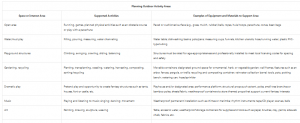
Planning Outdoor Activity Areas
| Planning Outdoor Activity Areas | ||
|---|---|---|
| Space or Interest Area | Supported Activities | Examples of Equipment and Materials to Support Area |
| Open area | Running, games, planned physical activities such as an obstacle course or play with a parachute | Paved or cushioned surface (e.g., grass, mulch, rubber) balls, ropes, hula hoops, parachute, cones, bean bags |
| Water/mud play | Filling, pouring, measuring, water channeling | Water table; dishwashing basins; pots/pans; measuring cups, funnels, kitchen utensils, hose/running water; plastic PVC-type tubing |
| Playground structures | Climbing, swinging, crawling, sliding, balancing | Structures must be rated for age-appropriateness and professionally installed to meet local licensing codes for spacing and safety |
| Gardening, recycling | Planting, transplanting, weeding, watering, harvesting, composting, sorting/recycling | Movable containers; designated ground space for ornamental, herb, or vegetable garden; wall frames, features such as an arbor, fences, pergola, or trellis; recycling and composting container; rainwater collection barrel; tools, pots, potting bench; watering can; hose/sprinkler |
| Dramatic play | Pretend play and opportunity to create fantasy structures such as tents, houses, fort or castle, etc. | Playhouse and/or designated area; performance platform; structural props such as tent, poles, small tree branches or bamboo poles, sheets/fabric; weatherproof containers to store themed props that support current fantasy interests |
| Music | Playing and listening to music; singing; dancing; movement | Weatherproof permanent installation such as chimes or marimba; rhythm instruments; tape/CD player; scarves, bells |
| Art | Painting, drawing, sculpture, weaving | Table, access to water, weatherproof storage containers for supplies and tools such as paper, brushes, clay, paints, sidewalk chalk, fabrics, etc. |
| Gathering space | Relaxing, conversation, storytelling/reading, performing, providing directions or instructions | Defined area with decking, paving stones, grass, small sitting wall, etc.; weatherproof chairs or stools; tree stumps; picnic table |
| Sand/digging | Sifting, pouring, digging, scooping, measuring, etc. | Sandbox or pit, covered to protect from animals when not in use; weatherproof construction toys such as trucks, cars, bulldozers, etc. |
| Science and observation | Collecting, sorting, observing and recording | Bins for sorting found or provided objects such as stones, leaves, sticks, shells, bark, etc. |
| Construction | Building | Flat platform or building space; weatherproof blocks or other items that can be used for construction (hammers, wood scraps, nails, etc.) |
| Vehicles | Riding, scooting, pushing, pulling | Wagons, trikes (must meet safety regulations); scooters; paved or hard-packed surface that provides track or pathways for riding that will not interfere with or provide safety concerns for other children; traffic cones or signs; bridge/tunnel |
| Hills | Rolling, sliding, crawling | Small earthen mound or inclined space covered with grass or cushioning material |
| Source: Nature Explore Sourcebook (Arbor Foundation, 2012). | ||
Table 8.2 Planning Outdoor Activity Areas
8.2 Motor Skills
Gross and fine motor activities and materials are designed to help children develop muscle strength and the ability to control large and small muscle groups effectively. Many of the physical activities that help children stay fit advance the development of these skills as well.
Gross Motor Skills
iStockphoto / Thinkstock
Teachers can use many activities and materials to promote the acquisition and development of coordination, balance, agility, power, and speed (Gallahue & Ozmun, 2006)the gross motor skills that involve the large muscles of the body both in isolation and in coordinated movements. Locomotor movement involves moving from one spot to another; axial movement occurs while the child is in place.
Activities that can promote these gross motor skills include:
- For coordination: jumping, hopping, skipping, dribbling, throwing, catching, kicking, pedaling
- For balance: walking or running on line or beam, standing on one foot, spinning, twisting, bending forward and backward, squatting
- For agility: moving sideways, starting/stopping, stepping, navigating obstacles, crawling, rolling, tumbling, twisting, jumping rope
- For power: vertical jumping, long jumping, distance throwing and kicking, lifting, pedaling
- For speed: running, walking fast
Materials and Equipment
In addition to permanent playground structures designed for climbing, swinging, and sliding, early childhood educators should have and regularly use a variety of materials and equipment to promote the attainment of gross motor skills. Table 8.3 provides a list of small equipment items and the type of development they support.
Active Games
The list of traditional games that promote gross motor skills is long and old. Many games such as tag and hide and seek that children play today have been used for centuries, handed down from one generation to the next. Children don’t always have access to equipment, and games with simple rules are easy to remember. The open-ended nature of games like these also makes them responsive to the coming and going of players, without a definitive beginning or ending.